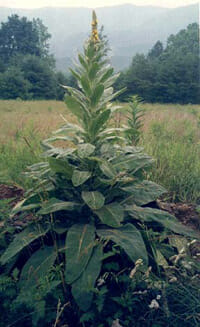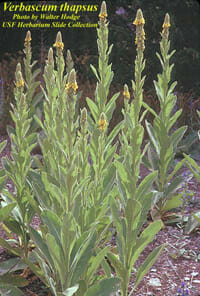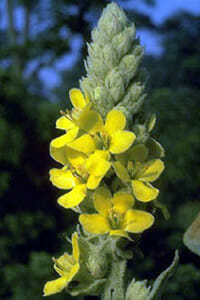Common Mullein – Scrophulariales Scropulariaceae Verbascum thapsus
 |
 |
 |
Identification & Description:
Common mullein, also known as wooly mullein, velvet dock, flannel leaf, Aaron’s rod, torch plant, and miner’s candle is a member of the figwort family.
Originally, Common mullein was brought over from Europe by early settlers. It was used as a medicinal herb in the treatment of coughs and diarrhea and as a respiratory stimulant for the lungs when smoked. A methanol extract from this plant has also been used an an insecticide for mosquito larvae.
Common Mullein is a weed usually found in waste places (open areas where the ground has been disturbed). Other places it grows include fields, roadsides, streamsides, gardens, and forest openings. It doesn’t like shade.
Mullein is usually recognized by its tall flower spikes, which can be 10 feet tall. It has pretty flowers, but only a few bloom at a time, so most people don’t think mullein is very attractive.
Common Mullein is a pioneer plant, so it is one of the first plants to grow in a place that has burned or otherwise been disturbed.
Mullein is biennial, so it lives for two years. The first year, this plant grows a rosette, but no flower stalk. The rosette survives through Winter, and the flower stalk grows the second year. At the end of the second year, the plant dies.
The rosette leaves are large and soft. They are bluish-green and grow up to 12 inches long and 5 inches wide. Most people compare the soft surface of a leaf to felt.
Common Mullein flowers are yellow with five petals. Flowers are about an inch wide. They bloom a few at a time from June to September.
Mullein produce huge numbers of seeds. One mullein plant may make over 100,000 seeds in a year. Seeds can survive almost any conditions and can last up to 100 years. Since mullein can’t grow in shade, the seeds can lay in the soil, waiting until plants around them die or are removed.
It grows faster than many of our native plants, and can crowd out other pioneers in a field. Later, when grasses take over the field, mulleins can’t compete, so they die, leaving only their dead flower stalks.
Only a few animals use mullein for food. Certain species of thrips, stinkbugs, weevils, and leaf bugs will eat mullein leaves; but these are insects which were brought over from Europe. Short-horned Grasshoppers, such as the Differential Grasshopper, will also eat leaves.
American Goldfinches, Indigo Buntings, and a few other birds eat mullein seeds.
Common Mullein provide shelter for insects in the winter. Since rosettes survive through the cold weather, leaves provide warm and protection for ladybugs, plant bugs, and black bugs, among others.
Hummingbirds sometimes use the soft leaves to line their nests.
Many insects come to mullein flowers for nectar. Bumble bees, honey bees, and hover flies help pollinate these plants.
Several species of fungi become parasites of Common Mullein, including Powdery Mildew.
Common Mullein grows best in dry, sandy soil.
Other plants which may be found near Common Mullein include weeds and grasses, such as Smooth Crabgrass, Common Dandelion, Switchgrass, English Plantain, Common Milkweed, thistles, Common Ragweed, Lamb’s Quarters, Queen Anne’s Lace, and Jimsonweed.
Physical Characteristics
Biennial growing to 1.8m. It is hardy to zone 3 and is not frost tender. It is in flower from June to August, and the seeds ripen from August to September. The flowers are hermaphrodite (have both male and female organs) and are pollinated by Flies and Lepidoptera (Moths & Butterflies). The plant is self-fertile. We rate it 2 out of 5 for usefulness.
The plant prefers light (sandy), medium (loamy) and heavy (clay) soils and requires well-drained soil. The plant prefers acid, neutral and basic (alkaline) soils and can grow in very alkaline soil. It cannot grow in the shade. It requires dry or moist soil. The plant can tolerates strong winds but not maritime exposure.
Flowers
Many flowers occur in a dense spike at the end of the flowering stem. These spikes may reach as much as 20 inches in length. Flowers are yellow in color, approximately 1 inch in diameter, and consist of five petals.
Edible Uses
Tea.
An aromatic, slightly bitter tea can be made by infusing the dried leaves in boiling water for 5 – 10 minutes.
A sweeter tea can be made by infusing the fresh or dried flowers.
Other Uses
Dye; Insecticide; Insulation; Lighting; Tinder; Wick.
A yellow dye is obtained from the flowers by boiling them in water. When used with dilute sulphuric acid they produce a rather permanent green dye, this becomes brown with the addition of alkalis
An infusion of the flowers is sometimes used to dye the hair a golden colour.
The flowering stems can be dipped in wax and used as torches.
The down on the leaves and stems makes an excellent tinder when quite dry. It is also used as an insulation in shoes to keep the feet warm and to make wicks for candle.
One report says that the leaves contain rotenone, though it does not say in what quantity. Rotenone is used as an insecticide.
Cultivation details
An easily grown plant, it succeeds in most well-drained soils, including dry ones, and prefers a sunny position. Dislikes shade and wet soils. Thrives on chalk. Prefers a light soil.
Hybridizes with other members of this genus, though the progeny are usually sterile.
A very ornamental plant, it often self-sows, especially on dry calcareous soils.